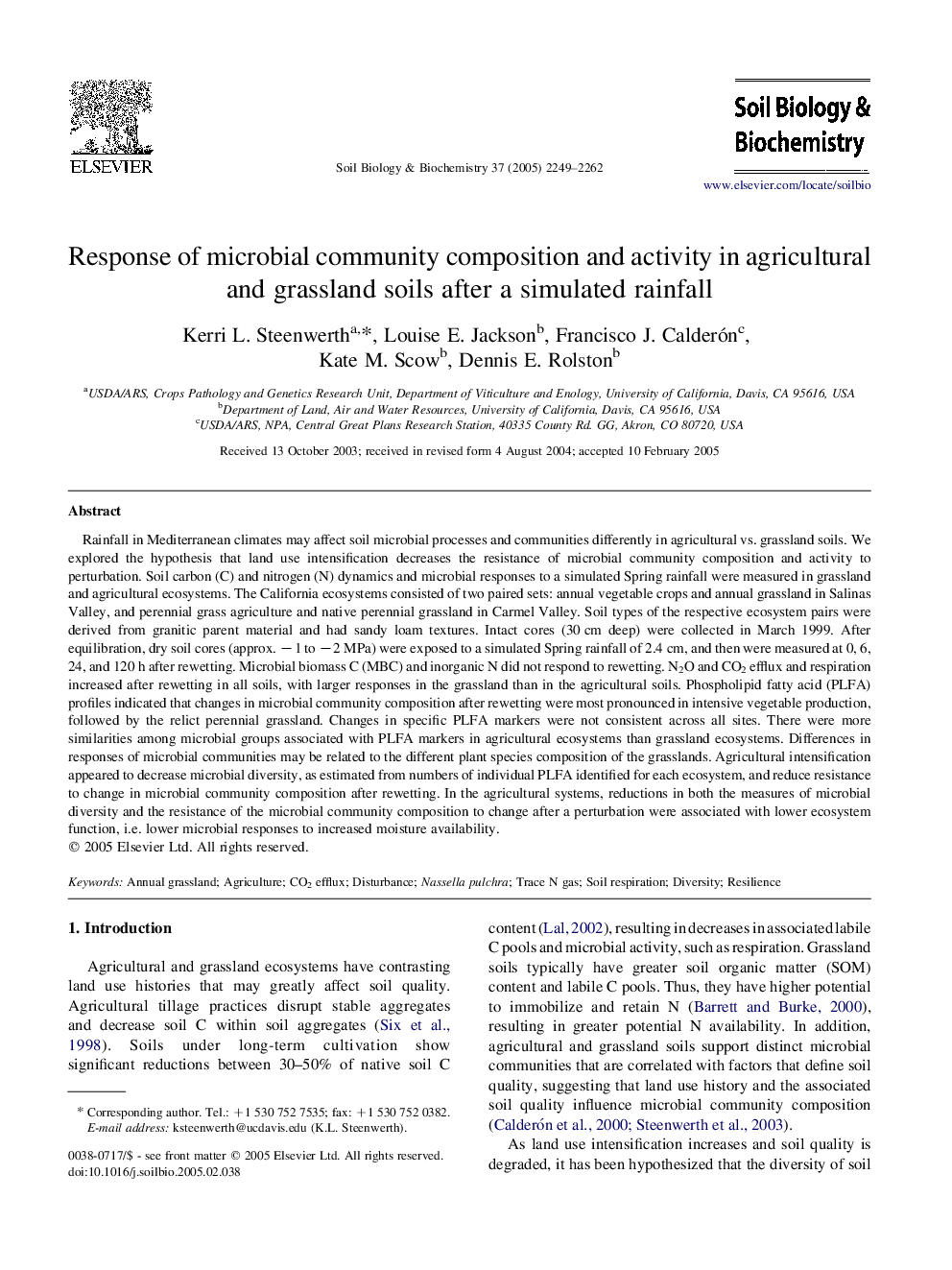| کد مقاله | کد نشریه | سال انتشار | مقاله انگلیسی | نسخه تمام متن |
|---|---|---|---|---|
| 2026507 | 1070032 | 2005 | 14 صفحه PDF | دانلود رایگان |
عنوان انگلیسی مقاله ISI
Response of microbial community composition and activity in agricultural and grassland soils after a simulated rainfall
دانلود مقاله + سفارش ترجمه
دانلود مقاله ISI انگلیسی
رایگان برای ایرانیان
کلمات کلیدی
موضوعات مرتبط
علوم زیستی و بیوفناوری
علوم کشاورزی و بیولوژیک
دانش خاک شناسی
پیش نمایش صفحه اول مقاله

چکیده انگلیسی
Rainfall in Mediterranean climates may affect soil microbial processes and communities differently in agricultural vs. grassland soils. We explored the hypothesis that land use intensification decreases the resistance of microbial community composition and activity to perturbation. Soil carbon (C) and nitrogen (N) dynamics and microbial responses to a simulated Spring rainfall were measured in grassland and agricultural ecosystems. The California ecosystems consisted of two paired sets: annual vegetable crops and annual grassland in Salinas Valley, and perennial grass agriculture and native perennial grassland in Carmel Valley. Soil types of the respective ecosystem pairs were derived from granitic parent material and had sandy loam textures. Intact cores (30Â cm deep) were collected in March 1999. After equilibration, dry soil cores (approx. â1 to â2Â MPa) were exposed to a simulated Spring rainfall of 2.4Â cm, and then were measured at 0, 6, 24, and 120Â h after rewetting. Microbial biomass C (MBC) and inorganic N did not respond to rewetting. N2O and CO2 efflux and respiration increased after rewetting in all soils, with larger responses in the grassland than in the agricultural soils. Phospholipid fatty acid (PLFA) profiles indicated that changes in microbial community composition after rewetting were most pronounced in intensive vegetable production, followed by the relict perennial grassland. Changes in specific PLFA markers were not consistent across all sites. There were more similarities among microbial groups associated with PLFA markers in agricultural ecosystems than grassland ecosystems. Differences in responses of microbial communities may be related to the different plant species composition of the grasslands. Agricultural intensification appeared to decrease microbial diversity, as estimated from numbers of individual PLFA identified for each ecosystem, and reduce resistance to change in microbial community composition after rewetting. In the agricultural systems, reductions in both the measures of microbial diversity and the resistance of the microbial community composition to change after a perturbation were associated with lower ecosystem function, i.e. lower microbial responses to increased moisture availability.
ناشر
Database: Elsevier - ScienceDirect (ساینس دایرکت)
Journal: Soil Biology and Biochemistry - Volume 37, Issue 12, December 2005, Pages 2249-2262
Journal: Soil Biology and Biochemistry - Volume 37, Issue 12, December 2005, Pages 2249-2262
نویسندگان
Kerri L. Steenwerth, Louise E. Jackson, Francisco J. Calderón, Kate M. Scow, Dennis E. Rolston,